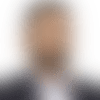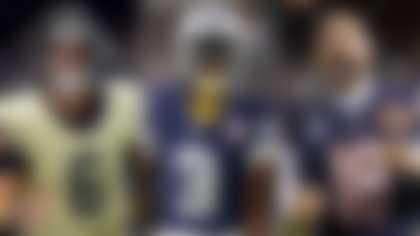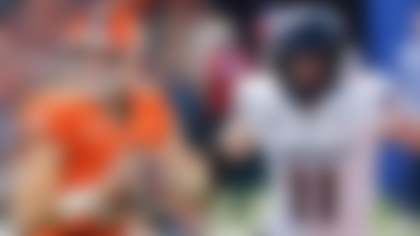As the 2021 NFL free agency period draws nearer, here is a look at the major needs for each team in the NFC.
NOTE: All cap-space projections were taken from Over The Cap on March 10. All other cap figures also come from Over The Cap unless otherwise specified.
Needs: Cornerback, outside linebacker, wide receiver.
Projected cap space: $14.6 million.
The Cardinals were the first team to make a big free-agent splash this offseason, signing defensive end J.J. Watt last week. Pairing a future Hall of Fame defender with a premier pass-rusher like Chandler Jones (who missed 11 games last season because of a biceps injury) should improve a squad that surprisingly finished in the top five in the NFL in sacks (48) last year. Yet, the Cardinals still need to reconfigure the defensive side, with several key unrestricted free agents set to hit the market. The most notable is linebacker Haason Reddick, who led the team in sacks (12.5) during a timely breakout season following Arizona's decision to decline the fifth-year option that would have kept the 2017 first-round pick in town in 2021. Whether or not the Cardinals can afford to keep fellow LB Markus Golden remains to be seen. Either way, the cornerback situation is in need of the most attention in the coming days. Starters Patrick Peterson and Dre Kirkpatrick are about to become 30-plus-year-old UFAs, and the market may get competitive at this premium position. Kliff Kingsbury and Co. should also be looking for a wide receiver to take some pressure and attention off DeAndre Hopkins, whether or not Larry Fitzgerald, 37, decides to return for his 18th season. That said, adding a pricey WR2 would be a luxury at this point, considering the list of potential free agency casualties also includes the starting right side of the offensive line (guard J.R. Sweezy and tackle Kelvin Beachum), tight end Dan Arnold, the special teams unit (kicker Zane Gonzalez and punter Andy Lee) and running back Kenyan Drake, who may just be replaced by budding three-year veteran Chase Edmonds. There is plenty of work left to do in the desert.
Needs: Pass rusher, running back, secondary.
Projected cap space: -$14.2 million.
New general manager Terry Fontenot and head coach Arthur Smith have a complicated high-wire act ahead of them as they balance building for the future on a cap-strapped roster that needs to also win now. The change in philosophy was needed, but the results of this exploratory-type season may determine how much longer Atlanta mainstays like Matt Ryan and Julio Jones stick around. One immediate need is improving a pass rush that ranked 23rd in sacks (with 29) last year. The deficiency contributed to the failure of a young secondary that allowed the most passing yards per game in the league (293.6). Starting safeties Keanu Neal and Damontae Kazee are both pending free agents, which will need to be addressed, but the best way to help a defense that has great pieces like Grady Jarrett and the energizing linebacking duo of Deion Jones and Foyesade Oluokun would be to upgrade the pass rush. Offensively, Smith must implement his system and see who fits where, with nine offensive starters returning. Center Alex Mack and running back Todd Gurley are the most notable soon-to-be FAs on the roster. Given the dire cap situation, Mack might be too pricey to retain. As for Gurley, bargains at running back have proven successful for other teams as of late, and there are a handful of free-agent backs capable of executing the power running attack that motored Smith's offense in Tennessee. An upgrade is needed for a ground game that ranked 31st in the league in yards per carry (3.7) in 2020. Making Ryan and Jones' likely last stand in Atlanta successful will be a tricky proposition but not impossible.
Needs: Offensive line, linebacker, pass-catcher.
Projected cap space: $24.1 million.
Expect the Panthers to be busy come March 17 whether through free agency or the trade market. The first order of business was retaining the team's best offensive lineman, tackle Taylor Moton, who received the franchise tag. But there are still three starting O-linemen facing unrestricted free agency (tackle Russell Okung and guards Michael Schofield and John Miller), and the Panthers may look to upgrade what was a middle-of-the-road squad last year, which wouldn't be a bad idea ahead of the expected return of a healthy Christian McCaffrey at running back. Staying on the offensive side, Curtis Samuel (851 receiving yards, 200 rushing yards and five total touchdowns) is sure to receive plenty of enticing offers in free agency after a breakout Year 4. Carolina is bound to either re-sign Samuel or add a new pass-catcher, though the Panthers' offseason could go in several directions, given the team's cap flexibility and the myriad potential opportunities to add talent suddenly popping up around the league (like in, say, Houston?). As for improving a young defense, this particular free-agent class presents a chance to add a game-changing, veteran linebacker -- a presence that's been missing in Carolina since Luke Kuechly's retirement in January of 2020. (Tahir Whitehead, who was brought in on a one-year deal to fill that role last season, is seemingly on his way out.) Adding depth to the young defensive front would help, too, but the Panthers shouldn't let the chance to stabilize this position pass.
Needs: Quarterback, wide receiver, offensive line.
Projected cap space: -$17.6 million.
There may be no head coach-general manager tandem under more pressure to succeed than Matt Nagy and Ryan Pace this upcoming season. The two are smartly holding their cards close to the vest, but there's no mistaking Chicago's priorities. Nick Foles will be the only quarterback signed to the roster as the new league year starts. Mitchell Trubisky, set to become an unrestricted free agent, could come back on a bargain deal, but the prospect of a second QB competition between the two should be even less enthralling than it was last offseason. Whether through free agency or trade, the Bears should look to make a move at QB -- and there will be a certain veteran QB available who is familiar with Nagy. In addition to potential cap casualties, the completion of the QB hunt could be the first domino to fall in Chicago. Retaining wideout Allen Robinson, who's proved to be Chicago's best offensive weapon, via the franchise tag will likely do little to mend a relationship that seems to have slowly deteriorated. Changes and upgrades on offense will be necessary in order to prevent an above-average defense (which has nine starters returning) from being sunk by the offense again. Depth on the Bears' offensive and defensive lines make up most of their 22 unrestricted free agents, with guard Germain Ifedi and defensive ends Roy Robertson-Harris and Mario Edwards highlighting the long list. Improving the O-line may supersede patching up potential losses on defense. Given the Bears' cap situation, Nagy and Pace need to get creative, even if that means making unexpected changes.
Needs: Secondary, edge rusher, offensive line.
Projected cap space: $834,273.
One day ahead of March 9's franchise tag deadline, the Cowboys cemented their long-term future by signing quarterback Dak Prescott to a massive, four-year, $160 million contract. Prescott, who topped Gregg Rosenthal's list of the top 101 free agents of 2021, would've been the Cowboys' top priority in free agency, but now the team can look ahead to improving a roster whose weakness amplified the value of Prescott during his absence last season. The Dallas defense is in need of attention, with five starters hitting free agency. Headlining that list are defensive end Aldon Smith, safety Xavier Woods and cornerback Chidobe Awuzie. They could be in play to return, but even so, an upgrade is needed for a defense that allowed a franchise-record 473 points last season. The secondary was hamstrung by injuries to top CBs Awuzie and Trevon Diggs, which exposed an already thin corps of young, unproven corners. Any improvement at defensive back would be welcome for a unit that has been lackluster for years -- you'd have to go back to the days of a young Roy Williams to find an exciting playmaker in the Dallas secondary. Since then, there have been various failed attempts at securing the back end, with these attempts more recently taking the form of cheap, one-year deals. There's opportunity to address this ongoing issue, but it would take a different strategy (like spending money). Strong safety Donovan Wilson, a sixth-round pick in 2019, had a knack for making plays in the 10 games he started last season, and pairing him with an upgrade at free safety would be ideal. The Cowboys could also use a complementary upgrade for Diggs, the Cowboys' best cover corner. Improving both positions would be a bonus, but in light of Smith's potential exit, there will be a need for an edge rusher, which would also help boost a struggling pass defense. Upkeep to the Cowboys' offensive-line depth may also be accomplished via free agency. It would also behoove Dallas to seek a backup QB (Andy Dalton is a pending FA) as Prescott returns from the horrific injury he suffered in October. With the can-kicking on Prescott's future finally over with, the Cowboys have secured an edge, locking Prescott in to run a high-profile offense in a flimsy division, but ensuring success past a potential NFC East title requires more work this offseason.
Needs: Wide receiver, defensive line, defensive back.
Projected cap space: $723,865.
Like the Falcons, the Lions are another NFC franchise undertaking a much-needed directional shift this offseason. The roster will go through plenty of changes in the coming months, if the swap of longtime quarterback Matthew Stafford to the Rams in exchange for Jared Goff and a pair of first-round picks didn't indicate that already. Next on the to-do list for new GM Brad Holmes: reshaping a receiving corps that features six players headed for unrestricted free agency. Kenny Golladay, the team's No. 1 WR, has proven himself worthy of a big payday, and he'll have his chance to seek one after the Lions decided not to tag him. Marvin Jones, Danny Amendola and Jamal Agnew (who returns all the kicks), meanwhile, could be headed elsewhere; Jones, in fact, might be as good as gone after leading the Lions in receiving yards, catches and receiving touchdowns in 2020. The process of restocking the pass-catching corps started with the signing of free agent Tyrell Williams. And that's just the beginning of a different brand of football in the Dan Campbell era. Detroit's defense will also be reimagined after the firing of Matt Patricia. Given the cap squeeze, cap casualties and restructurings are sure to come on the defensive side (cornerback Desmond Trufant is set to be among the first), but clues as to the biggest defensive need may only come after the dust settles. Adding a game-changing defensive lineman would be a great start for a squad that underperformed on all three levels. Linebacker Jarrad Davis, a former-first-round pick, and starting safety Duron Harmon are the most notable UFAs on defense, but acquiring a veteran corner to play alongside Jeff Okudah could do wonders for the 2020 third overall selection after a slow first season. It will be interesting to see how the Lions try to finagle their way to prosperity. Let's just hope Campbell's press conferences aren't the most entertaining part.
Needs: Interior offensive line, running back, cornerback.
Projected cap space: -$9.7 million.
The Packers have a couple of high-profile players set to become free agents and are currently projected to be over the cap -- and they refrained from using the franchise tag to keep any of them. Running back Aaron Jones and All-Pro center Corey Linsley, respectively No. 3 and 11 on Rosenthal's top 101 free-agent list, have been important figures in the offense in recent years, and it will be a tough blow to lose either. With running back Jamaal Williams (741 scrimmage yards, three total touchdowns) also headed for free agency, the Packers might have to change up what was an awesome one-two punch; 2020 second-rounder A.J. Dillon waits in the wings. Keeping Linsley will be a much pricier proposition, and considering guard Lane Taylor is also eying free agency, the interior O-line of the Packers should be the priority, in order to protect Aaron Rodgers as he approaches age 38. The Packers have already started chipping away at their cap problem with the release of tackle Rick Wagner and linebacker Christian Kirksey (both FA additions last year), but more cap casualties could be ahead. That could create some opportunity in an intriguing market at wide receiver, but with the recent growth of Allen Lazard and Marquez Valdes-Scantling, the Packers may want to first look at a veteran cornerback, with Kevin King -- a starter who was picked on in the 2020 NFC Championship Game -- becoming a free agent. Depth at the defensive line is another need for Green Bay, but the core of a winning football team is still there, as long as the Packers can maintain their level of offensive prowess.
Needs: Pass rusher, wide receiver, cornerback.
Projected cap space: -$33.1 million.
The Rams are headed into a tricky offseason that will require plenty of maneuvering, given the combination of a bad cap situation and the lack of high draft picks to fill in the gaps. Trading Jared Goff to the Lions for Matthew Stafford was just the start for the new-look Rams, but the process of improving this roster and retaining key free agents will be as complicated as it is hard to predict. The acquisition of Stafford, however, does make plain that Sean McVay wanted to reconfigure a Rams offense that regressed the past two seasons, turning surprisingly conservative in 2020. A deep threat would perfectly round out a dynamic receiving corps for Stafford -- adding one may be a priority for a team that faces looming cap casualties and key free agents to be. Marvin Jones, a teammate of Stafford's in Detroit, would be a dream addition for the Rams, but there's work to be done before considering that kind of luxury move. Regardless, expect the Rams to add a speedy deep threat at WR. Featured on L.A.'s list of FAs are pass rusher Leonard Floyd, center Austin Blythe, safety John Johnson and slot corner Troy Hill. Floyd fulfilled a one-year deal with a career-high 10.5 sacks last season and is destined to be rewarded in the coming months. That production must be replaced, should he go elsewhere, because having another pass-rushing threat on the defensive line is essential to freeing up Aaron Donald. Blythe has been a versatile interior lineman for the Rams the past three seasons, and keeping him would be ideal, though the O-line does have depth. The same goes for Johnson's potential exit from the defensive backfield. In regards to Hill, his specialized skill set at the slot position is imperative to maintaining one of the league's best secondary units.
Needs: Offensive line, defensive line, cornerback
Projected cap space: -$2.4 million
A significant majority of Vikings starters are set to return in 2021, but improving this roster is a must for head coach Mike Zimmer, whose seat could get warmer entering his eighth season. Upgrading the trenches should take precedence in Minnesota; this would smartly play to the team's strengths. The Vikings ranked fifth in the NFL with 142.7 rushing yards per game, and augmenting the O-line would make trying to stop running back Dalvin Cook (1,557 rushing yards in 2020) an even scarier proposition than it already is. Left guard Dakota Dozier is the only starter on offense facing free agency, and upgrading that spot or reshuffling the interior line would require securing some cap relief or restructuring contracts (this started with the release of longtime tight end Kyle Rudolph). As for the defensive line, the returns of Danielle Hunter (who missed 2020 with a neck injury) and Michael Pierce (a COVID opt-out) could be seen as pseudo-additions after their season-long absences. Their presence can also reignite pass rusher Anthony Barr. The Vikings' defense was decimated by opposing rushers last season, with Minnesota allowing 134.4 rushing yards per game (27th in the NFL). There are a handful of veteran free-agents who could make the D-line an even bigger strength. The porous run defense and inconsistent pass rush may've set up the young secondary for failure last season; still, adding a defensive back wouldn't hurt, if it can be managed.
Needs: Quarterback, tight end, safety.
Projected cap space: -$31.9 million.
The restructuring of contracts, the exploration of trades, the cap casualties and the release of a fan-favorite punter have set the tone for the dire salary-cap situation that has befallen New Orleans. The game of numbers will continue for the Saints in the coming days and weeks. Barring an unforeseen trade involving high-profile players, don't expect New Orleans to be big shoppers in the free agent market. Retaining key players would be an accomplishment in itself -- per NFL Network Insider Ian Rapoport, the recent revamping of deals is part of the Saints' plan to re-sign quarterback Jameis Winston. This may clue us into Drew Brees' impending decision regarding his potential retirement. Regardless of what happens with Brees, like any team facing questions about its starting QB, New Orleans will do its due diligence at the position, and it makes sense that this includes working to retain the in-house backup. With the recent release of tight ends Jared Cook and Josh Hill, the Saints created a need for a pass-catching tight end (unless Taysom Hill becomes the first five-tool footballer). Perhaps the bigger casualty of their dilemma, however, would be the potential loss of defensive end Trey Hendrickson, an unrestricted free agent who will be fielding big offers after a tremendous 13.5-sack Year 4. The Saints may just roll with Marcus Davenport and Noah Spence if they cannot re-sign Hendrickson, but they most certainly needed to address free safety, with starter Marcus Williams, PJ Williams and D.J. Swearinger becoming UFAs. Thus, they tagged Marcus Williams, who will help maintain what was one of the league's best secondary units last year.
Needs: Defensive line, wide receiver, offensive tackle.
Projected cap space: -$7.9 million.
The Giants' defense was a surprising bright spot in a whirlwind year. Things started with Saquon Barkley's season-ending knee injury in Week 2, followed by a midseason hot-streak in a bad division, then ended with the Giants losing steam toward the dreadful finish line of the NFC East title race. It was Daniel Jones' 80-yard highlight run rolled into one season. The defense kept this group in the running in a lowly division, and Leonard Williams was a big part of Big Blue's defensive success, so it makes sense that the team tagged him for a second straight season. Run-stuffer Dalvin Tomlinson is also a UFA, but will there be room to hang on to him, too? As for the Giants' woeful offense (ranked 31st at 17.5 points per game in 2020), Jones faces a crucial season in 2021, with the team set to truly figure out if it will go forward with the 2019 first-rounder at QB. Setting Jones up for success will help that evaluation, and a dynamic wideout will be needed alongside Darius Slayton after the release of Golden Tate. There are several other FA items the Giants need to address, including backups for Jones and Barkley (Colt McCoy and Wayne Gallman are UFAs), but enhancing the offensive line would help mend Jones' issues under pressure. Tackle Nate Solder is set to return after opting out of the 2020 season, but his pricey contract could make him a cap casualty. Cam Fleming, who started in Solder's place last year, is a UFA. Considering this Giants' defense was largely improved through free agency, there is still hope that a productive offense can be patched together, especially with the return of Barkley.
Needs: Quarterback, defensive back, tight end
Projected cap space: -$26.9 million
With the Band-Aid already pulled in the Eagles' deliberations at quarterback, they move on from the Carson Wentz era and enter a youth movement under rookie head coach Nick Sirianni. The Eagles have offseason moves on deck and have restructured a couple of contracts to help repair a critical cap situation. More drastic action is certainly on the way, with reports of multiple teams being interested in trading for longtime tight end Zach Ertz, which would create a need, with Sirianni often running "12" personnel. The Eagles will have to rummage through this year's free-agent class, barring any other unforeseen moves. A veteran quarterback should be in play, in order to help boost Jalen Hurts' sophomore season, whether by offering mentorship or competition. The personnel on offense isn't all that bad, despite a young set of receivers (who could use a veteran presence). However, the formula for success in 2021 relies on the health of the Eagles' aging offensive line, which had a nightmare-type season. The same goes for Philly's defense, which will be powered by its deep squad of linemen. Behind them is where the Eagles could use free agency upgrades, particularly at defensive back. Jalen Mills, a corner turned strong safety, Cre'Von LeBlanc, the oft-injured slot corner, and Nickell Robey-Coleman are set to become unrestricted free agents. An influx of fresh bodies to a corps that has had tough luck in recent times could turn things around. Finding a utilitarian corner opposite Darius Slay would be one of those moves that makes all the difference. Because everyone's got a shot at the NFC East demolition derby.
Needs: Offensive tackle, cornerback, quarterback.
Projected cap space: $24 million.
No team was plagued more by injuries than the 2020 49ers, and no team may be more amped up to get back in contention. Last year's treacherous season was ill-timed for a deep roster coming off a Super Bowl appearance. Curing the hangover will require some spending. Perhaps the most important unrestricted free agent on the roster (which is set to have 27 total UFAs) is left tackle Trent Williams, whose potential exit would create a complicated situation for an otherwise-thin O-line. The 49ers have the cap space to retain the former All-Pro, and Williams has expressed his desire to remain in San Francisco, but not at a discount. Getting ink to paper would be reassuring; otherwise, the Niners may end up panic-buying a replacement that, in all likelihood, ends up being a downgrade. The cornerback unit is sure to see the most changes this offseason, through free agency and the draft. The team will be parting ways with veteran Richard Sherman; other notable CBs headed for free agency include Jason Verrett, Ahkello Witherspoon, K'Waun Williams and Dontae Johnson. A featured CB is needed, and so is a breath of fresh air for a secondary that has underperformed as of late. By all accounts, the 49ers are sticking with quarterback Jimmy Garoppolo after a setback season doomed by injuries. A backup plan could be in the works through free agency, given the expiring contracts of C.J. Beathard and Nick Mullens. If no QB is signed, that will give us a pretty good idea of who the 49ers will target with the No. 12 overall draft pick.
Needs: Offensive line, cornerback, edge rusher.
Projected cap space: $20.6 million.
Russell Wilson has already made it clear what he thinks the Seahawks need going forward, but his frustrations have set the table for a nervous offseason in Seattle, with said frustrations attracting the notice of other teams. Fixing this potential crisis begins with upgrading an offensive line that allowed 48 sacks (tied for fifth-most in the NFL) of Wilson last season, marking the third straight season he'd been sacked at least 48 times. Center Ethan Pocic and backup tackle Cedric Ogbuehi are the only unrestricted free agents of the bunch, but the Seahawks could really use a major improvement at any O-line position -- maybe even more than one, after the retirement of Mike Iupati. Running back Chris Carson and wide receivers David Moore and Philip Dorsett are potential losses in free agency, but there are more pressing needs on defense. The Seahawks will attempt to retain top cornerback Shaquil Griffin, though they'll do so without resorting to the tag. Locking in Griffin is important, given the threat of losing fellow CBs Quinton Dunbar, Neiko Thorpe and Lano Hill to the market. Adding a veteran corner opposite Griffin would be a nice luxury. The release of edge rusher Carlos Dunlap, a midseason trade acquisition, necessitates a replacement -- but if that's the kind of move it takes to keep your franchise quarterback, so be it.
Needs: Linebacker, defensive line, running back.
Projected cap space: -$5.5 million.
As the defending Super Bowl champs go for two, Buccaneers head coach Bruce Arians is optimistic about retaining much of the roster. That will be a challenge for a team with 25 pending free agents, many of whom contributed to last month's dismantling of the Kansas City Chiefs in Super Bowl LV. With wide receiver Chris Godwin receiving the franchise tag, the Bucs can look to maintain their high-flying defense. Linebackers Shaquil Barrett and Lavonte David will be sought-after commodities around the league coming off superb playoff performances. Keeping Barrett, a valued 28-year-old pass rusher, will be the pricier of the two propositions. It's reasonable to wonder if David, a nine-year veteran in Tampa, could be willing to work out a team-friendly deal, but there's no disputing money well-earned. The rest of the Bucs' LB corps is thin, outside of third-year phenom Devin White. With defensive tackle Ndamukong Suh being another key unrestricted free agent, keeping at least two of those three (Barrett, David, Suh) is realistic. Retaining running back Leonard Fournette may require the Bucs to negotiate with competing offers. The 26-year-old could end up being a long-term solution after falling into success in Tampa, but the Bucs could also survive with a cheaper replacement or a top rookie. Other notable UFAs (tight end Rob Gronkowski, WR Antonio Brown and kicker Ryan Succop) will round out a busy year for GM Jason Licht. Keeping the Bucs together will be tough, but anyone cynical about their chances is underestimating the power of a Tom Brady group text.
Needs: Quarterback, guard, wide receiver.
Projected cap space: $39 million.
Washington has plenty of cap room available, so expect the Football Team to be aggressors in the free-agent and/or trade markets, with a main focus on improving a stagnant offense. They are moving on from 36-year-old quarterback Alex Smith even after he helped push the franchise to its first NFC East title in five years, capturing the Comeback Player of the Year award in the process. Taylor Heinicke, who came out of nowhere late in the season as a backup, has already been re-signed, but there is a glaring need for a proven starting QB who can help make good use of a budding defense. With all the QB rumblings going on around the NFL, Washington should play a major role in an intriguing offseason. Brandon Scherff, who was franchise-tagged last season, was tagged again this year -- Washington shouldn't waste any time locking up one of the best guards in the game. Although it may end up dependent on who they settle at QB, Washington has an opportunity to get a big-name receiver in this free-agent crop who complements Terry McLaurin, or vice-versa. Acquiring speed at the position is a need, as well. Defensively, Washington will only get better after a breakout 2020 in which that unit pretty much won the NFC East. Aside from minor upkeep and perhaps the re-signing of stalwart defensive end Ryan Kerrigan, the franchise's all-time sack leader, Washington's defense -- led by a stout front -- is poised to keep D.C. in the running during what is sure to be another wild and crazy NFC East ride.
Follow Michael Baca on Twitter.




























